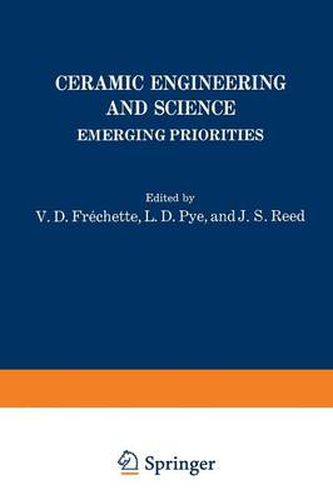Readings Newsletter
Become a Readings Member to make your shopping experience even easier.
Sign in or sign up for free!
You’re not far away from qualifying for FREE standard shipping within Australia
You’ve qualified for FREE standard shipping within Australia
The cart is loading…






This title is printed to order. This book may have been self-published. If so, we cannot guarantee the quality of the content. In the main most books will have gone through the editing process however some may not. We therefore suggest that you be aware of this before ordering this book. If in doubt check either the author or publisher’s details as we are unable to accept any returns unless they are faulty. Please contact us if you have any questions.
The Conference on Emerging Priorities in Ceramic Engineer ing and Science, held at Alfred University, November 4-6, 1974, was arranged to provide a basis for reassessment of professional goals, procedures and outlook. American priorities among comfort, safety, national prestige, security, convenience and environmental quality are significantly different from those of a dozen years ago. Economic factors have shifted, as exempli fied by scarcities in energy, mate rials and world food supplies. At the same time, demands for safer products, healthier work ing conditions and fairer rules of behavior are making them selves felt. Governmental, corporate and consumer interests are all involved and they are intricately inte rrelated. Higher education, for its part, must not only respond wisely to changing student attitude, itself a part of the national scene, but must gain perspective toward the present and toward changes of yet unknown nature which can be expected in the future. Persistent and pointed questions from engineers, managers, and students were an indication to us of wide-spread concern to understand the new pattern of priorities that is presently emerging. In response to this need, Conference papers were invited from distinguished engineers, scientists, and other specialists; their willingness to contribute from their expertise and their thinking is very much appreciated by the editors. The first four chapters of the volume deal with the larger scene and with the viewpoints of those concerned with it in behalf of government, corporations and the professions.
$9.00 standard shipping within Australia
FREE standard shipping within Australia for orders over $100.00
Express & International shipping calculated at checkout
This title is printed to order. This book may have been self-published. If so, we cannot guarantee the quality of the content. In the main most books will have gone through the editing process however some may not. We therefore suggest that you be aware of this before ordering this book. If in doubt check either the author or publisher’s details as we are unable to accept any returns unless they are faulty. Please contact us if you have any questions.
The Conference on Emerging Priorities in Ceramic Engineer ing and Science, held at Alfred University, November 4-6, 1974, was arranged to provide a basis for reassessment of professional goals, procedures and outlook. American priorities among comfort, safety, national prestige, security, convenience and environmental quality are significantly different from those of a dozen years ago. Economic factors have shifted, as exempli fied by scarcities in energy, mate rials and world food supplies. At the same time, demands for safer products, healthier work ing conditions and fairer rules of behavior are making them selves felt. Governmental, corporate and consumer interests are all involved and they are intricately inte rrelated. Higher education, for its part, must not only respond wisely to changing student attitude, itself a part of the national scene, but must gain perspective toward the present and toward changes of yet unknown nature which can be expected in the future. Persistent and pointed questions from engineers, managers, and students were an indication to us of wide-spread concern to understand the new pattern of priorities that is presently emerging. In response to this need, Conference papers were invited from distinguished engineers, scientists, and other specialists; their willingness to contribute from their expertise and their thinking is very much appreciated by the editors. The first four chapters of the volume deal with the larger scene and with the viewpoints of those concerned with it in behalf of government, corporations and the professions.